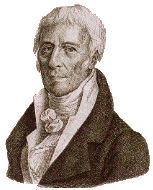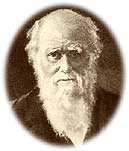 Featured
Scientist: Jean Baptiste de Lamarck
Featured
Scientist: Jean Baptiste de Lamarck
Notes for Chapter 6:
Organic Evolution
Click link to return to Lecture
Schedule
or back to Chapter 10
or ahead to Chapter 31
Chapter 6 Assignment:
Ch. 6: 104-123, 129-132; RQ6:
1,2,5,8,10,12
(pp. 115-120 will not be emphasized, but read for review
purposes)
Note: These lecture notes are less extensive than past notes because there are so many excellent online web pages on these topics already. Of these I recommend consulting the three links to pages by Dennis O'Neil below.
Introduction: A Legacy of Change
Featured Animal:
Trilobites
I. Origins of Darwinian Evolutionary Theory
Key Terms: inheritance of acquired characteristics, transformational vs. variational theory (Lamarck vs. Darwin), uniformitarianism (Charles Lyell)
 Featured
Scientist: Jean Baptiste de Lamarck
Featured
Scientist: Jean Baptiste de Lamarck
Links: 1 - 2 - 3 - and especially 4 (Michael Ghiselin's excellent account of textbook falacies about what Lamarck said)
Excellent notes are available from Dennis O'Neil's (Palomar College) website:
Pre-Darwinian Theories
and Historically
Influential Publications
(also see links below for links on Darwinian evolutionary theory)
A. Pre-Darwinian Evolutionary Ideas
1. Pre-scientific notions emphasized static species view and young Earth
2. Lamarck had transformational view of evolution (acquired characteristics)
3. In contrast, Darwin’s theory is variational, due to differential reproduction
4. Influences on DarwinGeologist Lyell: principle of uniformitarianism (Fig. 6-3),
a. Uniformitarianism consists of two important principles:1) Laws of physics and chemistry remain same throughout Earth’s history.
2) Past geological events can be explained by today’s natural processesb. Fossils likewise explainable by natural forces acting over long periods
c. Earth (and life) must be millions of years old.
d. Geological changes are natural and without direction
II. Darwinian Evolutionary Theory: The Evidence
Key Terms: fossil, Cambrian Period (see mnemonic devices and charts helpful in memorizing geological periods), Burgess Shale (see lecture 1 notes), law of stratigraphy (relative dating), radiometric dating methods (absolute dating), common descent, phylogeny, homology, nested hierarchy, phyletic gradulism vs. punctuated equilibrium (p. 120), natural selection (study carefully), adaptation
 Featured
Scientist: Charles Robert Darwin
Featured
Scientist: Charles Robert Darwin
Excellent notes are available from Dennis O'Neil's (Palomar College) website:
Evidence of Evolution and Darwin
and Natural Selection
Browse Darwin's Origin of Species (1st Edition) online
The Evidence for Darwin’s Evolutionary Theory:
A. Living and fossil organisms constantly changing
B. Sedimentary rock layers indicate an ancient Earth
(Notion of “Deep” Time - Geologist Lyell)
C. Many evolutionary trends are apparent (e.g., horses)
D. Patterns in nature are hierarchically nested as expected from Darwin’s “common descent” (click here for bird example from lecture)
E. Homology between structures is evidence for evolution
F. Animals tend to be more similar earlier in ontogeny
G. Multitude of species on Earth suggests branching history
H. Gradual changes can add up, given enough time (Examples from lecture: Darwin's worm stone and coral reef formation, also used as an examples of Darwin's application of the notion of uniformitarianism to ecological and geological studies, respectively).
Cambrian Explosion: Burgess Shale
Pattern: Major “phyla” of bilaterian animals appear “suddenly” (~10 My) 544 Mya (million years ago)
1. Fossils of first large animals with skeletonsa) were tiny ancestors present much earlier?
b) was increase in oxygen responsible?2. What were large soft-bodied Precambrian animals? Relatives or unrelated?
3. Why have no “new phyla” evolved since the Cambrian?
III. Revisions of Darwin's Theory (not emphasized)
IV. Microevolutionary Genetic Variation and Change within Species (not emphasized)
V. Macroevolution: Major Evolutionary Events
Key Terms: speciation (= cladogenesis), five major mass extinction events (Fig. 6-32), species selection
Click link to return to Lecture
Schedule
or back to Chapter 10
or ahead to Chapter 31
This page created 8/21/01 © D.J. Eernisse, Last Modified 9/4/01, Links Last Completely Checked 8/21/01